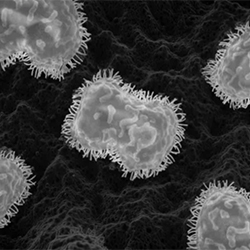Originally published by our sister publication Infectious Disease Special Edition
By Marie Rosenthal, MS
More data from the STOMP (Study of Tecovirimat for Mpox) trial presented at CROI 2025, held in San Francisco, confirm that tecovirimat does not reduce the time to clinical resolution of clade II mpox lesions or improve pain among adults, according to Timothy Wilkin, MD, MPH, a professor of medicine and the chief of the Division of Infectious Diseases and Global Public Health at the University of California San Diego, La Jolla.

STOMP was a randomized, double-blind, placebo-controlled trial of tecovirimat (TPOXX, SIGA Technologies) for the treatment of people with symptomatic mpox. STOMP was stopped in 2024 when an interim analysis showed that tecovirimat monotherapy was ineffective in the study population. STOMP was started in 2022 as part of the U.S. response to the clade II mpox outbreak because there are no approved treatments for mpox. However, tecovirimat is indicated to treat smallpox based on animal model data.
“As you may know, the CDC had tecovirimat available through an expanded access program, and 8,000 to 10,000 people have been treated in the absence of clinical trial data,” Dr. Wilkin said at a press briefing during CROI.
Although it is an extremely painful disease, most people do well and recover without complications, he said. “But there are some people, especially those with immune suppression that have very severe, prolonged and occasionally fatal courses for mpox,” he explained.
Diane Havlir, MD, the CROI chair, agreed: “We need to get treatments and for people who have it. Yes, most people get better, but there’s a lot of suffering,” she said at the briefing.
STOMP was a large international study with 67 sites in seven countries—Argentina, Brazil, Japan, Mexico, Peru, Thailand and the United States, including Puerto Rico—that enrolled people with symptomatic mpox. A complementary study called PALM007 in the Democratic Republic of Congo reported similar findings.
The study was double-blind for some participants, but for children, pregnant women, study participants with certain skin conditions or who were severely immunocompromised, and those who had severe mpox disease were assigned to an open-label study arm, and all received tecovirimat.
STOMP assessed the safety of the drug among all study participants and, in randomized arms, evaluated whether a 14-day course of tecovirimat monotherapy reduced the time to clinical resolution of visible mpox lesions and improved other outcome measures, such as pain, compared with placebo.
“We had people were followed weekly with for biospecimens and detailed data collection through two months. And we had very detailed patient-reported outcomes,” Dr. Wilkin said. “We enrolled around 700 [people] total; 413 were randomized. We enrolled people early in disease, so some people ended up not having mpox.”
That left them with about 350 patients, he said. The primary end point was time to clinical resolution, “which was time till all of the skin lesions were scabbed over or healed over, as well as all the mucosal disease that we could see,” Dr. Wilkin explained.
Randomized participants reported experiencing mpox symptoms for a median of eight days before study entry and had a median of nine mpox lesions. About one-third of participants reported severe pain, selecting scores of 7 to 10 on an 11-point scale. By day 29 following study entry, an estimated 83% of participants receiving tecovirimat had reached clinical resolution, compared with 84% who received placebo, a non-significant difference.
Among those reporting severe pain at baseline, improvements were similar between those who received tecovirimat and placebo, with average pain scores decreasing by 3.2 points for participants receiving tecovirimat and by 3.1 points among those receiving placebo.
They found “absolutely no discernible difference” between tecovirimat and placebo, Dr. Wilkin said. “Everybody generally got better over the course of four weeks, and there was no difference between the groups. We did find that the tecovirimat was quite safe. There were no real problems that we observed from it.
“In addition, our study focused on pain outcomes. About one-third of people had severe pain when they entered the study, meaning 7 to 10 out of 11 on the numeric rating scale,” he said.
“We also looked at viral decay, so looking at mpox virus and skin lesions and rectal swabs, blood, oropharynx. And again, we saw no clear difference. I will say there was a bit of a difference, a bit more clearance with tecovirimat, but it didn’t reach statistical significance,” Dr. Wilkin said.
A separate exploratory analysis of data collected in STOMP’s open-label arm before the study had closed aimed to determine whether any factors were associated with faster mpox lesion resolution in participants with or at elevated risk for severe mpox. Faster clinical resolution was observed in participants who were younger in age or who did not have HIV or were living with HIV but virally suppressed on antiretroviral therapy; however, no association was significant when considering the duration of symptoms before study entry. The investigators noted that STOMP open-label participants had fewer lesions but slower clinical resolution than reported from the PALM007 trial.
He said moving forward, more work needs to be done to find a successful treatment.
“We need treatments for mpox. Generally, most people get well, but there are those subgroups of people that are at risk for very severe disease,” he said, so he hopes trials can continue that might look at whether combination medications could be effective.
He also expressed doubts about tecovirimat’s possible effectiveness against smallpox—it is currently being stockpiled in case of a biological attack.
“I will add that tecovirimat is approved for smallpox. In the case of a bioterrorist attack, if it didn’t work for mpox, the animal model in which the approval for the smallpox indication was made, I don’t think we can feel comfortable that it would work for smallpox in the case of a bioterrorist attack,” he said. “So that is another reason why we need additional studies and investment in this area.”




